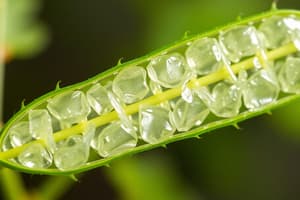Podcast
Questions and Answers
What is the main responsibility of light-independent reactions in photosynthesis?
What is the main responsibility of light-independent reactions in photosynthesis?
- Absorbing light energy
- Transporting nutrients to the chloroplasts
- Producing oxygen
- Synthesizing glucose from carbon dioxide and water (correct)
Which enzyme is crucial in the carbon fixation step of photosynthesis?
Which enzyme is crucial in the carbon fixation step of photosynthesis?
- Chlorophyll
- NADP
- Glyceraldehyde-3-phosphate dehydrogenase (GAPDH)
- Rubisco (correct)
How are 3-PGA molecules converted in the reduction step of photosynthesis?
How are 3-PGA molecules converted in the reduction step of photosynthesis?
- Reduced to 3-phosphoglyceraldehyde (3-PGA) (correct)
- Converted to oxygen
- Converted to glucose
- Converted to carbon dioxide
Which factor does NOT influence the rate of photosynthesis?
Which factor does NOT influence the rate of photosynthesis?
Where do light-independent reactions take place?
Where do light-independent reactions take place?
What is the main function of chlorophyll in photosynthesis?
What is the main function of chlorophyll in photosynthesis?
What is the primary function of chloroplasts in a plant cell?
What is the primary function of chloroplasts in a plant cell?
Which of the following pigments is NOT a primary photosynthetic pigment?
Which of the following pigments is NOT a primary photosynthetic pigment?
How does temperature affect the rate of photosynthesis?
How does temperature affect the rate of photosynthesis?
In which part of the chloroplast do photosystems reside?
In which part of the chloroplast do photosystems reside?
What factor stimulates photosynthesis by providing an essential energy source?
What factor stimulates photosynthesis by providing an essential energy source?
Which process takes place within the chloroplast's thylakoids?
Which process takes place within the chloroplast's thylakoids?
Study Notes
Photosynthesis
Photosynthesis is the process by which green plants convert sunlight, carbon dioxide, and water into glucose, oxygen, and other organic compounds. This process takes place in the chloroplasts of green plant cells, specifically within their chlorophyll-containing organelles called thylakoids.
Chloroplast Structure
Chloroplasts have a double membrane structure consisting of two phospholipid bilayers. They contain various organelles such as grana (stacked thylakoid membranes), stroma (intermembrane space where the photosystems are located), intergranal lamellae (secondary stacks of thylakoids), and stroma thylakoids (single stack of thylakoids).
Photosynthetic Pigments
Photosynthetic pigments are molecules involved in the absorption and transfer of light energy during photosynthesis. The primary pigments include chlorophylls (a, b, and c) and carotenoids (β-carotene, lutein, violaxanthin, and zeaxanthin).
Factors Affecting Photosynthesis
- Light: Light is the energy source for the photosynthetic process. The light intensity and quality, as well as the duration of illumination, can affect the rate of photosynthesis.
- Temperature: High temperatures can enhance the rate of photosynthesis, while low temperatures can inhibit it.
- CO2 concentration: CO2 concentration in the environment can affect the rate of photosynthesis. High CO2 levels can stimulate photosynthesis, while low CO2 levels can limit it.
- Water: Adequate water supply is crucial for photosynthesis, as water is a necessary component of the process and is absorbed through plant roots.
- Soil nutrients: The availability of essential nutrients like nitrogen, phosphorus, and potassium can influence the rate of photosynthesis.
Light-Independent Reactions (Carbon Fixation)
Light-independent reactions, also known as the Calvin cycle, occur in the stroma of the chloroplasts and are responsible for the synthesis of glucose from carbon dioxide and water. This process involves three main steps:
- Carbon fixation: The enzyme RuBisCO (Ribulose-1,5-bisphosphate carboxylase/oxygenase) catalyzes the reaction between carbon dioxide and ribulose-1,5-bisphosphate (RuBP) to form two molecules of 3-phosphoglycerate (3-PGA).
- Reduction: The 3-PGA molecules are reduced to 3-phosphoglyceraldehyde (3-PGA) by the NADP-dependent enzyme glyceraldehyde-3-phosphate dehydrogenase (GAPDH).
- Regeneration: The 3-PGA and glyceraldehyde-3-phosphate (G3P) are interconverted to regenerate the starting molecule, RuBP, and to form glucose.
In summary, photosynthesis is a complex process that involves the conversion of light energy into chemical energy, which is then stored in the form of glucose and other organic compounds. The structure of the chloroplast, the presence of photosynthetic pigments, and the influence of various factors contribute to the efficiency of photosynthesis.
Studying That Suits You
Use AI to generate personalized quizzes and flashcards to suit your learning preferences.
Description
Explore the key aspects of photosynthesis, including chloroplast structure, photosynthetic pigments, and factors influencing the process. Learn about the light-independent reactions (Calvin cycle) involved in carbon fixation and glucose synthesis.




